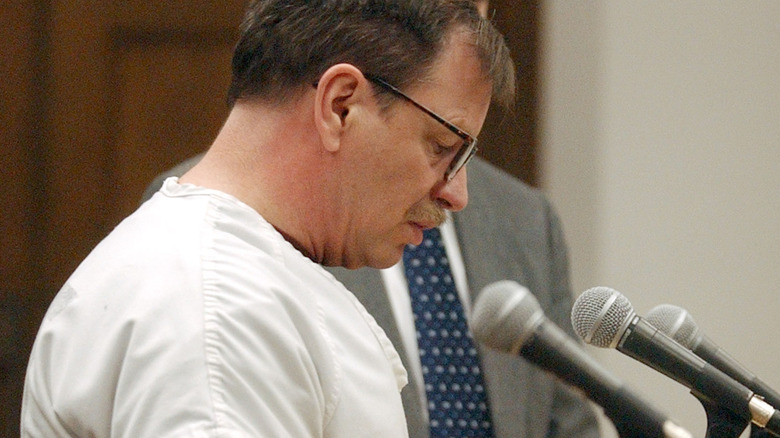The Chilling Details Of The Green River Killer
Through the 1980s and 1990s, authorities in Washington were stymied by a rising body count — all thanks to a murderer who would earn the ghoulish distinction of being one of the most prolific serial killers in United States history. Due to the number of bodies being found in the state's Green River, a simple but fitting name was given to the vicious murderer: the Green River Killer.
The Green River Killer would remain on the loose for nearly two decades, until an arrest was made in 2001, revealing the killer's identity as Gary Ridgway. Ridgway would go on to plead guilty to 48 murders but many have speculated that he was responsible for many more, with Ridgway himself claiming in 2013 to have killed more than 80 women (via Britannica).
What's perhaps most startling is that Ridgway was a suspect for years before his arrest, but investigators were unable to tie him to any of the crimes until forensic technology advanced.
The story of Ridgway's crimes would eventually come out, and as the Washington Post would put it in 2003, the details would show that Ridgway took a chillingly exacting and methodical — almost workman-like approach.
Gary Ridgway appeared to be a normal kid
According to Britannica, Ridgway was born on February 18, 1949, in Salt Lake City, Utah. His father worked as a bus driver, while his mother was a sales clerk. In 1960 the family moved to the Pacific Northwest, taking up residence in the city of SeaTac, Washington.
His home life was far from perfect. According to A&E, Ridgway's parents often argued. Ridgway also suffered from urinary incontinence until he was a teenager. He later alleged that his mother would berate him and wash him inappropriately when this occurred. Coincidentally, bedwetting is a part of the MacDonald Triad, a set of traits once used to assist in profiling serial killers which also included harming animals and setting fires. Ridgway reportedly did all three.
As a teenager, Ridgway stabbed a neighborhood child, with the victim later testifying that Ridgway's words to him following the attack were, "I always wanted to know what it felt like to kill somebody."
Still, those who knew Ridgway after as a kid wouldn't recall anything particularly unusual about him. His high school football coach described him to the Tacoma News Tribune as "A somewhat smallish kid. Wispy hair. Nondescript."
Gary Ridgway's early arrests
Even upon reaching adulthood, it seems as though Ridgway was largely able to continue his nondescript ways. A community college classmate told the Tacoma News Tribune that he recalled Ridgway as at least giving off the appearance of having been socially well-adjusted. "He never had any trouble getting a girlfriend or getting a date," the classmate said.
After high school, Ridgway entered the military, joining the United States Navy, according to A&E. He served in Vietnam, and it was there that Ridgway came into contact with the type of people who would go on to make up a large portion of his victims: sex workers.
After the war, Ridgway moved to the Seattle area where he started working as a truck painter. He also got married and divorced multiple times, with his marriages often deteriorating at least in part to his obsession with sex workers. According to Britannica, Ridgway was arrested in 1980 for allegedly choking a prostitute. He was arrested again in 1982 for solicitation, and it's believed that Ridgway started his killing spree around that time.
The Green River Killer begins his reign of terror
According to Biography, in July of 1982, some children discovered a girl's body floating in the Green River. It was the strangled body of 16-year-old Wendy Caulfield who had gone missing after leaving her foster home. Police didn't know it at the time but she would go on to be considered the Green River Killer's first victim.
Over the next several weeks many more women's bodies were discovered in the Green River or on its banks; all of them strangled like Caufield. As the bodies continued to pile up, it became clear to the police that they were dealing with a serial killer, and they started a task force.
What may come as a surprise — considering he wouldn't be arrested for another 20 years — is that Gary Ridgway became a suspect relatively early in the investigation. In April 1983, police were beginning to think he could've been involved after he fit the description of the suspect. One of the victims, an 18-year-old prostitute named Marie Malvar, had been seen by her boyfriend entering a truck driven by a man in his 30s or 40s with dark hair.
Police questioned Ridgway about Malvar but he said he didn't know her. What he revealed in 2003, though, is that he had purposely stood against a fence while talking to investigators, hoping to hide scratches on his arm which he had received from Malvar as she tried to escape. He also said that when investigators left, he burned the skin with battery acid to try and hide the scratches.
The police get unexpected help from another notorious killer
According to Biography in 1984, Gary Ridgway was still under suspicion and investigators had him take a polygraph test, which he passed.
In 1986, without much to go on, investigators turned to an unlikely consultant for help. Convicted serial killer Ted Bundy — who was awaiting his execution at the time — had read about the Green River Killer in newspapers and offered to help investigators. Investigators held discussions with Bundy, who reportedly stated his belief that the killer likely returned to where he had left his victims to perform sexual acts on the bodies. It's a disturbing hypothesis, but perhaps due to Bundy's killer instincts, it was correct. Ridgway later confirmed it, according to Biography.
Despite passing a polygraph test, Ridgway was still a suspect as he had been the last person seen with two of the victims. There was no evidence linking him to the crimes, but a new forensic tool — DNA testing — was going to change matters. In 1987, Ridgway provided a saliva sample to investigators, but there was a problem. According to Britannica, forensic DNA testing had not become sophisticated to provide any answers in the Green River Killer case, and wouldn't get to a point where it could tie Ridgway to the crime until 14 years later.
Gary Ridgway is revealed as the Green River Killer
In 2001, Investigators announced that they were able to link DNA found on victims' bodies to the saliva sample Ridgway had provided in 1987, per Biography. Ridgway was initially charged with the murders of four early victims whose bodies were recovered in 1983. At first, Ridgway claimed he was innocent but by the time his trial rolled around in 2003, he changed his tune and pleaded guilty (via Brittanica). This was part of a plea deal that took the death penalty off the table in exchange for a guilty plea on 48 counts (later, 49) of first-degree murder.
Ridgway admitted to killing most of his victims in his truck or house and then dumping their bodies elsewhere, but due to the high number of victims, he said he couldn't remember them all. "I killed so many women I have a hard time keeping them straight," he said (as reported by CNN). "Most of the time I killed them the first time I met them, and I do not have a good memory for their faces."
He is currently serving those consecutive life sentences with no possibility of parole and has agreed to help authorities locate additional missing victims. According to A&E, he is currently incarcerated at Washington State Penitentiary in Walla Walla, Washington.





